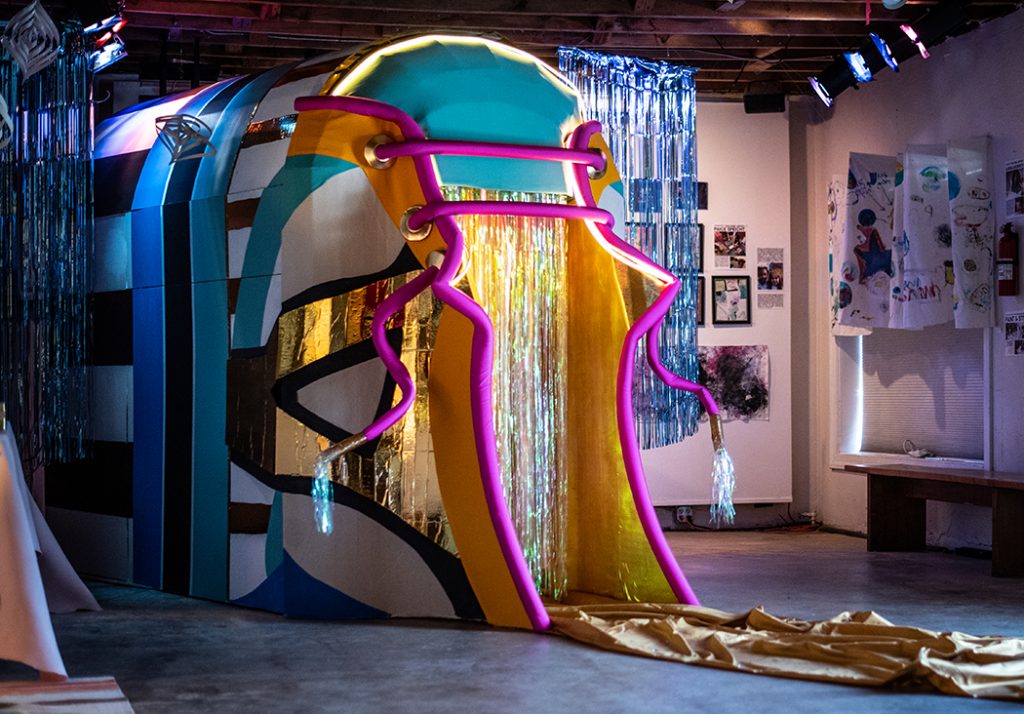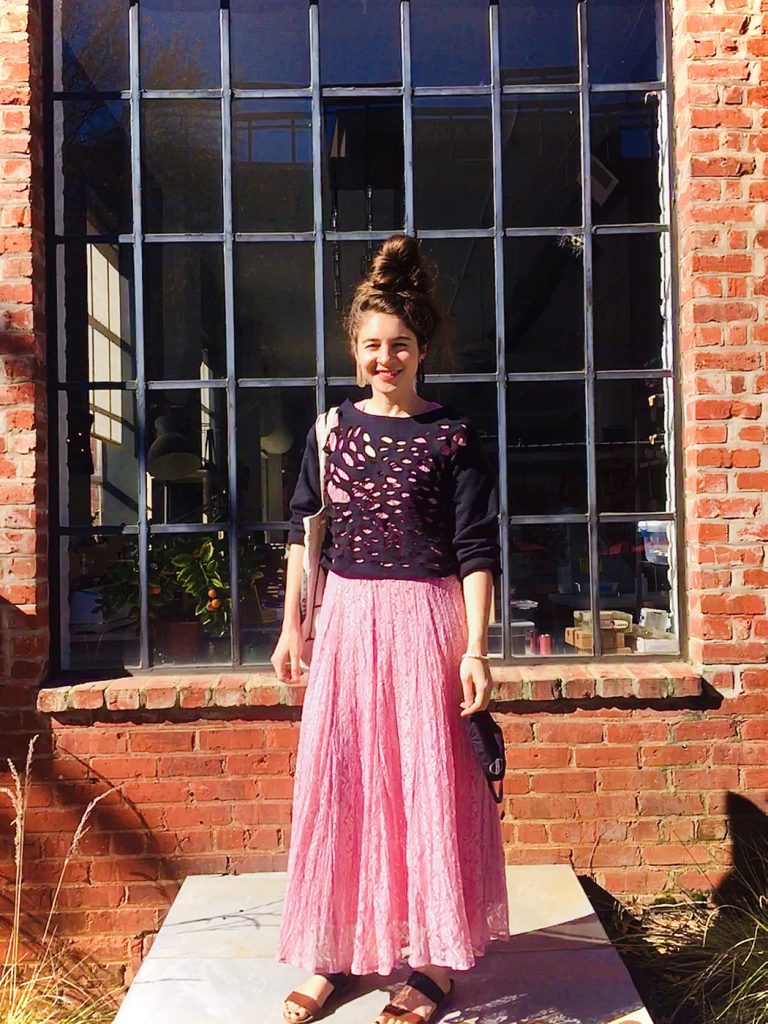There’s a direct connection to be made between the work of Playground of Empathy and its founders’ Instagram account, @cvillefashion. The organization works to promote diversity, equity, and inclusion through its interactive Walk in My Shoes experience (during which you enter a literal shoe and explore the personal belongings of someone who differs from you—in race, sexual orientation, physical ability, or otherwise). The Instagram account, which 434 will be collaborating with in this and subsequent issues, functions much the same: “We curated the CVille Fashion Instagram purely as a fun hobby,” says co-founder Micah Kessel, “but we soon realized that both projects were about creating more allies in the celebration of all of our identities.”
We asked Kessel to tell us more about @cvillefashion and how it connects to the greater mission of Playground of Empathy and the Walk in My Shoes experience.

434: Tell me about your organization’s inception.
Micah Kessel: Sharing the Walk in My Shoes Experience all over Charlottesville and the country, we have clearly seen the unexpected empathy created by discussing clothing, identity, point of view perspectives. So from early on, we developed this program with the country’s top scientists and business psychologists. As designers, we theorized that to make the greatest impact, we needed to work with the most experienced thinkers in their field, so that’s where we aimed from the beginning. By now, we’re grateful to conduct discussion and/or research in between the Harvard professor who invented the term implicit bias, the president of the Association for Psychological Sciences, and the chief of behavioral psychology at Accenture. Through our design work with these brilliant minds, we are realizing a couple of really important things about how DEI and social change is being approached in the wrong way by many throughout Charlottesville, and needed a few new important perspectives.
The first thing we realized was—after seeing what’s happened to this country and to Charlottesville in the last number of years—it’s clear that we all needed to do more, but that implicit bias is hard to defeat because we’re so affected by those around us. We discovered that the best way to make radical change in our communities, institutions, and organizations was not by trying to change the radicals! Instead, the best point of entry is through those who are well-intended and want to better allies, but lack the experience of really walking in other’s shoes—those who are ready but don’t yet know how.
The second thing we realized is that if we can get those well-intended, almost allies to truly engage in a celebration of diverse identities through clothing, immersive films, and discussions, that it becomes 100 times easier to help them to be more willing and comfortable to speak up for the rights of others.
How does the immersive experience work?
For decision makers, community, and organizational leaders working in diversity, equity and inclusion who have the sisyphean burden of creating change while lacking quality tools, buy in, and resources, the Walk in My Shoes Experience (walkintheshoe.com) creates powerful realizations in how to become a better advocate for your peers or team members. This process and program heals team relationships, reframes our biases, and develops the language of advocacy more powerfully than a typical DEI training or workshop. At Playground of Empathy, we facilitate Walk with your teams or classes to help remove the social mistakes made dozens of times a day, by well-intended “almost allies” who simply lack the exposure and understanding to be true allies.
Why did you start @cvillefashion? How does it fit into the ethos of Playground of Empathy?
Compared to the rigor and scientific deep dives of developing Walk in My Shoes, we curated the CVille Fashion Instagram purely as a fun hobby, but we soon realized that both projects were about creating more allies in the celebration of all of our identities. Most women, POC, and marginalized groups have incredible stories about their clothing and how they see themselves in terms of their identity. For those remaining (ahem) who are still bent on the idea of speaking the non-narrative of “I see myself as human,” we believe that sharing both the Walk in My Shoes Experience, and the CVille Fashion Insta, will give these folks too, an opportunity to say, “I see myself as a father, as a brother, as a guardian, as someone who has lost something, as someone who doesn’t know what his voice is supposed to be beyond people who look, act, and talk like me.”
We do things because we’re passionate about social change by celebrating empathy and identity. That’s also the reason we created this CVille Fashion Insta. Because yes, on one hand we’re a sophisticated group of creatives and scientists diving as deep as is imaginable. On the other hand, empathy is kindergarten rules: Be kind to each other, don’t be mean, listen when other people talk. We think the reason it can be hard to do this for others is because, frankly, we’re often not so nice to ourselves. So we teach perspectives by walking in the shoes of other people so that you can learn to see their perspectives better first. This unique approach to supporting DEI through immersive perspective building, teaches us in a deeper way how to see our biases before they negatively impact others. Then, by being nicer to others you’ll learn how to be nicer to yourself. Cyclically, by learning to be nice to yourself you’ll again learn how to be even nicer to others. That’s what being empathable, Walk in My Shoes, and what CVille Fashion is all about: making C’ville a playground of empathy for all.
CHARLOTTESVILLE STREET STYLE

Sam Fisher
Age: 31
Occupation: Watercolorist (fishersamuelharris.com), project manager at Lightbulb Machine
The look: Blue purse by Annie Temmink (strap by Foytik Leather), top from Darling, long skirt from Etsy
“Being genderqueer and closeted meant that I used to go out into the world every day wearing what felt like a costume, or maybe camouflage. My identity felt like a liability. When I was able to break free from that mindset, I was able to truly begin to play and embody my own identity within the context of my community. This outfit in particular was one of the first I put together that felt appropriate for the office while still feeling fashionable and authentic.”

Kelly Aima
Age: 30
Occupation: Founder and Design Consultant at AIMA Consulting and the Fashion Eutopia podcast
The look: Sports coat from Low Vintage
“Growing up as a child in Nigeria, fashion was my shield against my society’s negativity; I used fashion as a medium to channel my inner power, express my feelings. Serving as an experiential consultant energizes, motivates, keeps me on my feet virtually, and fosters my creativity. The use of fashion elements to stimulate intellectual conversations, curiosity, enhance creativity, and most importantly, make an impact is gratifying and makes me happy.”

Annie Temmink
Age:31
Occupation: Designer/artist (annietemmink.com) and interim technical director at Live Arts
The look: Dress from theater giveaway rack, earrings she designed for Angelo Jewelry, sweatshirt is her own design, bracelet of tiny skulls from a market in Oaxaca
“Being a creator of wearable and displayable art requires a lot of physical maneuvering, so I typically dress for function, in clothes that help me feel powerful and capable of crafting what I adore: textiles, big shapes, and carnival-style maximalist details. When I’ve spent a lot of time in more masculine, functional workwear, I feel a pull to balance out with my feminine side.”
